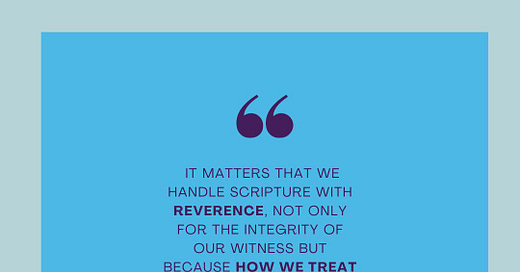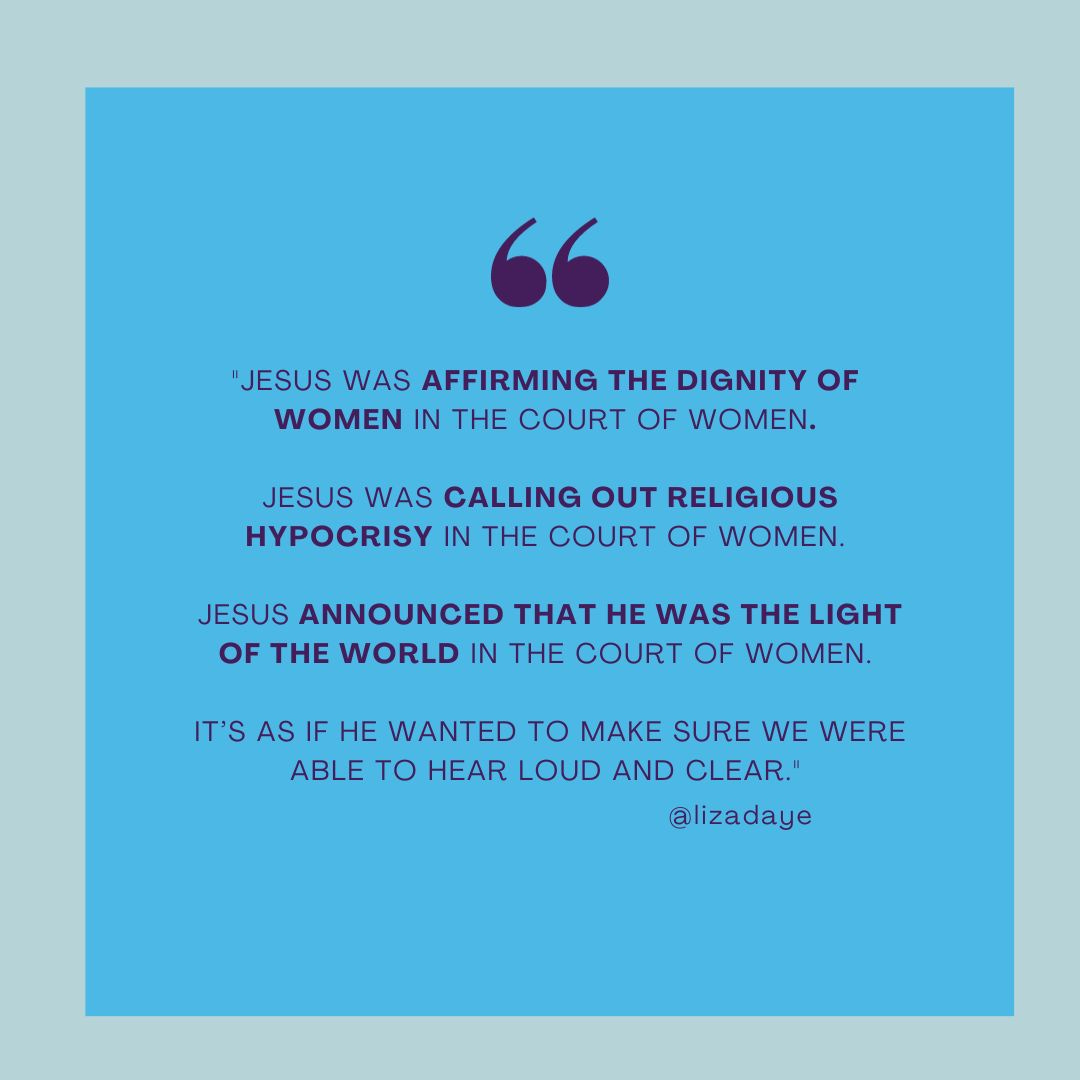The Story of the Malicious Pharisees
This week we're renaming the "adulterous woman" story and taking a look at how nearly every detail in John chapters 7-8 can be contextualized by the law.
In our current day and age, there’s no shortage of the weaponization of biblical text. We see it from the digital public square to discussions in real life. In fact, many of us who were trained in logic/rhetoric and classical debate adhered to an unspoken rule, that the person with the best proof texting skills was typically the winner of the argument. When engaging in debate, many of us hoped that the person we were debating didn’t actually know the primary source better than we did. Sometimes it was a bit of a gamble. In the story we’re looking at today, the Pharisees bet on themselves being able twist the law without Jesus noticing… and it didn’t go well for them.
But as we’ll see, it matters that we handle scripture with reverence, not only for the integrity of our witness, but because how we treat scripture reveals what we believe about who Jesus is. Ultimately, scripture does not exist to prove our menial points, but to point to the triune God and reveal what God is like. It matters then that when we’re reading scripture, we do so in context, and we use scripture to interpret scripture. When we leave things out, when we ignore important details, when we gloss over the good stuff in service of our own talking points, we often miss the point of the pericope entirely.
So, let’s take a peek at this story of scripture twisting in John 8, and explore why it matters, particularly for the women.
“Early in the morning he came to the temple courts again. All the people came to him, and he sat down and began to teach them. The experts in the law and the Pharisees brought a woman who had been caught committing adultery. They made her stand in front of them and said to Jesus, “Teacher, this woman was caught (by us) in the very act of adultery. In the law Moses commanded us to stone to death such women. What then do you say?” (Now they were asking this in an attempt to trap him, so that they could bring charges against him.) Jesus bent down and wrote on the ground with his finger. When they persisted in asking him, he stood up straight and replied, “Whoever among you is guiltless may be the first to throw a stone at her.” Then he bent over again and wrote on the ground.
Now when they heard this, they began to drift away one at a time, starting with the older ones, until Jesus was left alone with the woman standing before him. Jesus stood up straight and said to her, “Woman, where are they? Did no one condemn you?” She replied, “No one, Lord.” And Jesus said, “I do not condemn you either. Go, and from now on do not sin anymore.”
Then Jesus spoke to the crowd, “I am the light of the world! The one who follows me will never walk in darkness but will have the light of life.” Then a Pharisees objected, “You testify about yourself; your testimony is not true!” Jesus answered, “Even if I testify about myself, my testimony is true because I know where I came from and where I am going. But you people do not know where I came from or where I am going. You people judge by outward appearances; I do not judge anyone. But if I judge, my evaluation is accurate because I am not alone when I judge, but I and the Father who sent me do so together. It is written in your law that the testimony of two men is true. I testify about myself and the Father who sent me testifies about me.”
Then they began asking him, “Who is your father?” Jesus answered, “You do not know either me or my Father. If you knew me, you would know my Father too.” (Jesus spoke these words near the offering box in the court of women while he was teaching in the temple courts.”
First, let’s back up a little bit to the middle of chapter 7. The Feast of the Tabernacle is taking place, and one of the most important ceremonies during the Feast was the water pouring ceremony, which involved bringing water from a different source into the temple court and pouring it on the altar as an offering. It was a time for the Jewish people to remember their dependence on God for sustenance and protection during their wilderness journey. The Feast was also associated with messianic expectations, and it was widely believed that the Messiah would come during the festival.
So, what did Jesus do? On the last and most important day of the feast, Jesus called out in a bellowing voice “if anyone is thirsty, come to me and drink (7:37).” This would have sent shockwaves throughout the temple. Here, contextualized by the water pouring ceremony, Jesus was announcing his Messiahship plainly in a way the 2nd temple Jewish people would have understood, but he also makes a bold claim. To believe in Jesus in to become indwelled by the Spirit of the living God (7:39), which flows continually with rivers of living water (7:38).
In response to this provocative deviation from ritual, the crowd was divided. Was he really the Messiah? Or wasn’t he? (7:41) Pharisees were beside themselves (7:45-53). Their devotion was to the law (7:49), to their piety, and the power that was attached to it. While they wouldn’t have understood the fullness of what Jesus was announcing, they considered it an affront to their authority.
And what do pious people do when they feel threatened? They abuse scripture in ways that seek to serve themselves. But scripture was never designed to be a weapon against image bearers, and recently when studying this passage, I noticed something I’ve never noticed before.
So, in chapter 8, the Pharisees (still angry following the prior day’s provocative display), brought a woman to Jesus accusing her of adultery (8:3). We can observe right off the bat that the Pharisees are intent on weaponizing the law and asserting their status as eyewitnesses as laid out on Deut. 19:15. This commandment from God to the Israelites emphasized the importance of multiple witnesses to establish the truth in legal matters. It requires reliable testimony from at least two or three witnesses to establish guilt in a legal case, and according to Deuteronomy 17:17, the witnesses were responsible for casting the first stones.
Only one problem though. The command found in Deut. 22:22-24 prescribes severe penalties, including death by stoning, for those found guilty of offenses including adultery. The law instructs them to stone both the man and the woman. Where was the man? In their refusal to present the man alongside the woman, the witnesses were actually in violation of the law themselves.
But wait, there’s more.
In verse 7, Jesus says “He who is without any sin among you, let him be the first to throw as stone at her” before returned to writing in the dirt. So, let’s look at another law passage from Deuteronomy 19 that talks about the qualifications for legal witnesses.
“A single witness may not testify against another person for any trespass or sin that he commits….16 If a malicious and hypocritical witness testifies against another person and accuses him of a crime, 17 then both parties to the controversy must stand before the Lord, that is, before the priests and judges who will be in office in those days. 18 The judges will thoroughly investigate the matter, and if the witness should prove to be false and to have given false testimony against the accused, 19 you must do to him what he had intended to do to the accused. In this way you will purge the evil from among you. 20 The rest of the people will hear and become afraid to keep doing such evil among you.” Deut. 19:15-20
When we contextualize John 8:6 through the lens of Deuteronomy 19:15-20, Jesus wasn’t giving a new command or changing the law. He wasn’t even making a grandiose display of mercy in the way many of us have understood. Jesus was responding to Torah with Torah, confronting their malicious intent, their hypocrisy, and their scripture-twisting head on. Jesus was reminding them that according to the same law that they were attempting to weaponize, they were guilty and deserved the same punishment.
The woman wasn’t any more guilty than the Pharisees of violating the law that day.
But isn’t it funny that if we only pay attention to the chapter divisions and section titles that were added centuries later (often entitled things like “The Horrible Adulteress Woman”), we miss the interconnectedness of the story, not just between John 7and 8, but also the story that weaves itself throughout the narrative of scripture from Genesis to Revelation.
Speaking of the story, we all remember the ending, right?
No stones were cast that day.
And as the woman left, what did Jesus say to the temple crowd? He announced to them that he is the light of the world. This proclamation is contextualized by all of this! Then, a lingering Pharisee attempted to weaponize the law against Jesus one final time. But what did Jesus do? He reveals God as Father, and himself as the Son. The day before, He announced the coming of the Spirit for believers. This text is trinitarian through and through, y’all.
Jesus didn’t just obey the law, he embodied it. But while doing so, Jesus revealed himself as the long-anticipated Messiah who is God-the-Son. He revealed God as Father, and he announced the coming of the Holy Spirit.
When we reduce the story of the malicious pharisees to moralism, we ignore the larger context. When we pluck Jesus’ words like “I am the living water” and “I am the light of the world” outside of the story and impute them into a theological framework more concerned with memorizing “I am” statements than actually drinking living water and walking in the light, we remain thirsty and in the dark. The pharisees were legal *experts. * They knew this stuff. But Jesus told them plainly “You neither know me, nor my Father.” Ouch.
Do you want to know another fun detail? According to the NET Bible translation notes, where is this whole situation taking place? In the court of women. During the 2nd temple period, the temple was divided in different sections, and the court of women is where Jewish women could worship, learn, and participate in temple life. According to 8:20, Jesus was likely teaching here, near the offering receptacles.
Jesus was affirming the dignity of women in the court of women.
Jesus was calling out religious hypocrisy in the court of women.
Jesus announced that He was the light of the world in the court of women.
It’s as if he wanted to make sure we were able to hear loud and clear.
It is my hope that as we spend time in scripture, we treat it with reverence, and we resist the urge to twist it and weaponize it against others in service of our own ends.
May we pay attention to when and where the finger of God is writing at all times, whether it’s on tablets in Deuteronomy, in the dirt in John 8, or in our own hearts here and now.
As always, Thanks for being here and exploring scripture. I’m so glad you’re here. If you have thoughts, I’d love to hear them in the comments!






